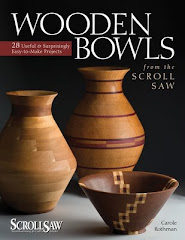Also, I saw some scroll saw bowls on display, and was pleased to see how well they were done. I especially like when someone takes the work off in their own direction, one I hadn't thought of. If you have a bowl that you've created that you're proud of, send me a picture so I can post it and share it with others.
Tuesday, March 30, 2010
Northeastern Woodworkers Association Show
I went to the Northeastern Woodworkers Association Show in Saratoga Springs last Saturday. Some really nice work done by the folks up there, and as usual, a lot of good energy. And, of course, I bought some "treats"--2 pieces of redwood burl and 2 small pieces of ebony. Problem for me with special wood is that I get so afraid of wasting it that I tend not to use it.
Tuesday, March 23, 2010
Problems with Patterns
Here's the last part of my series on why instructions are sometimes so difficult to follow successfully. It focuses on something that seemed clear to me, but apparently not to everyone. Hope this helps.
Labels:
patterns,
scroll saw,
wood bowls
Monday, March 15, 2010
Proofreading errors
No list of reasons why some instructions are difficult to follow successfully would be complete without including errors in the text or diagrams. If you've ever tried to proofread your own work, you know what a difficult task it is. You tend to see what you expect to see and overlook obvious mistakes. I still can't believe that instead of writing "(6) 6" x 3/8" carriage bolts", I left out one of the 6's. I checked the text many times, as did at least two other people and we all missed it. I am grateful, through the scroll saw forum, my blog, and my blog email, that I have a chance to provide a quick fix, rather than wait for the next printing. And I am grateful to those who have taken the time to ask for corrections and clarifications.
Wednesday, March 10, 2010
Unconscious Competence
I came across this term in a professional baking magazine, and think it helps explain why some instructions are harder to follow than others. The term refers to a situation where a teacher is so familiar with a given area that he or she forgets to break instructions down into all the steps a beginner needs. For example, if I direct the reader to "use the flexible pad sander to flare the upper lip" without a picture, video, or more detailed instructions, the reader is left clueless as to how to proceed. It's like a recipe instructing you to "cook until done" without telling you how long it should take, or what it should look like.
The best instructions are written by someone who has the skills of an expert, but can still think like a beginner. As you gain more competence in a particular area, you may find that instructions that were not clear when you began now make perfect sense.
Monday, March 8, 2010
I did it again!
After posting a caution about the importance of reading instructions, I ignored my own warning and had to redo my work. I was using Inlace, that resin that looks like stone, and it didn't harden properly over the padauk portion of my project. I scraped everything out, and decided that I should probably use acetone to clean up any oil from the wood before trying again. As I looked over the instructions that came with the Inlace, I found a clear warning to use acetone with oily exotic wood or the Inlace might not harden properly. Fortunately the area to be removed was small, and I only gouged my hand once trying to clean things up. Ironic--you'd think I'd know better by now!
Sunday, March 7, 2010
Confusing instructions: why does it happen?
I recently received the good news that my book is going into its second printing. This gave me the chance for corrections and clarifications to make the instructions more accurate and easier to follow. It also led me to think about the various causes of problems or confusion when someone tries to follow instructions.
For starters, sometimes problems arise when, in our eagerness to get going, we fail to read the introduction or notes that contain vital facts, and plunge right in. When I started making collapsible baskets, I wondered why my cutting angle was always different from the one recommended. Three years later, I noticed, for the first time, the sentence that clearly said that when you enlarge or reduce a pattern, you have to change the cutting angle. I still don't know how I missed it, but there it was.
However, sometimes even careful reading is not sufficient to prevent difficulties. Over the next few days, using my perspective as both a user and provider of instructions, I'll cover other factors that may interfere with the successful completion of a project.
Labels:
instructions,
patterns,
scroll saw,
wooden bowls
Subscribe to:
Comments (Atom)




